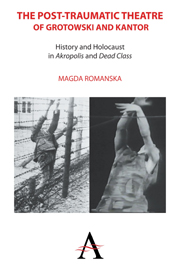 The Post-traumatic Theatre of Grotowski and Kantor
The Post-traumatic Theatre of Grotowski and Kantor from Part I - Our Auschwitz: Grotowski's Akropolis
In 1962, Eugene Barba, who was a student at Warsaw's Państwowa Wyższa Szkoła Teatralna (PWST, the National School of Theatre), came to Opole as part of his internship. Eventually, he became one of Grotowski's closest collaborators and his most ardent foreign supporter. Shortly after meeting Barba, Grotowski participated in the Eighth World's Youth Festival in Helsinki, where he also met Raymonde Temkine. She visited Opole in 1963, watched a special performance of Akropolis, and was greatly impressed by Grotowski's theatre. Those two contacts augmented international perspectives of Grotowski, but to reach wider audiences, Grotowski needed a concrete theatrical piece that would appeal to international tastes. As Dariusz Kosiński notes:
Grotowski was becoming more ambitious and certain of his artistic direction. What he needed was a model spectacle which would showcase both his theory and methodology, but which would also be international in its character. The adaptation of Wyspiański's Akropolis became such a spectacle. If we assume that Grotowski consciously constructed a spectacle to show the full range of his theatre's possibilities, then we can also assume that he chose the play as well as its setting because they naturally interest both Polish and international audiences.
As a showcase spectacle for a broader international audience, Akropolis fulfilled its function, but in Poland, initial reviews were mixed, to say the least. Puzyna notes that the production “provoked extremely tempestuous discussions.”
To save this book to your Kindle, first ensure [email protected] is added to your Approved Personal Document E-mail List under your Personal Document Settings on the Manage Your Content and Devices page of your Amazon account. Then enter the ‘name’ part of your Kindle email address below. Find out more about saving to your Kindle.
Note you can select to save to either the @free.kindle.com or @kindle.com variations. ‘@free.kindle.com’ emails are free but can only be saved to your device when it is connected to wi-fi. ‘@kindle.com’ emails can be delivered even when you are not connected to wi-fi, but note that service fees apply.
Find out more about the Kindle Personal Document Service.
To save content items to your account, please confirm that you agree to abide by our usage policies. If this is the first time you use this feature, you will be asked to authorise Cambridge Core to connect with your account. Find out more about saving content to Dropbox.
To save content items to your account, please confirm that you agree to abide by our usage policies. If this is the first time you use this feature, you will be asked to authorise Cambridge Core to connect with your account. Find out more about saving content to Google Drive.